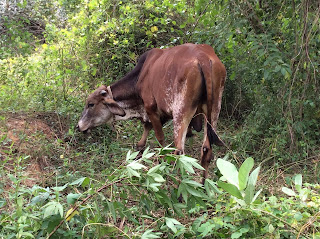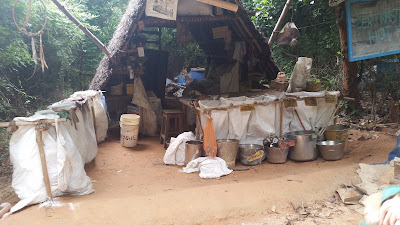I began to observe that some people here at Sadhana Forest have been choosing to pass up the delicious cooked food that is being served here in order to prepare their own raw meals. I began to ask questions and learned that the people here who eat this way do so with integrity because they have observed that eating only raw meals is giving them more and quicker energy throughout the day, and one person even explained that he thinks that raw food provides him with quicker cognition and mental clarity!
After trying some raw meals, I found that I did feel more energized, and that I did not feel bogged down or tired after the meal like I have when my body is digesting cooked grains and carbs.
I have also learned that Aviram, the founder of Sadhana Forest also chooses not to cook his food! He was inspired to eat raw foods here in India after he heard a man named Aris LaTham speak in Pondicherry. Here is a video from the speech that inspired him to eat raw foods.
https://www.youtube.com/watch?v=jUn0nySxkOI
and here is a movie that explains LaTham's ideas.
https://www.youtube.com/watch?v=Yh4gfaaV19A
Some Recipes:
Here are some of the raw and vegan concoctions that I have come to absolutely adore. It seems that I prefer to eat these meals and drinks, even more than the food at Sadhana Forest and hope to keep exploring recipes that I fully enjoy without having to cook any of it!
1. "Immune Booster Smoothie": a base of hemp seed milk or almond milk, dates, bananas, raw cocoa powder or nibs, and maca (I have noticed that I feel really excited and even sometimes euphoric after consuming maca!), cinnamon optional.
2. "Ironic Salad": raw sliced mushrooms (white or crimini), chopped green onions, shredded cucumber (almost shredded like spaghetti), dark lettuce or raw spinach, raw cashew cheese crumbles, spirulina, salt, a bit of oil, surrounded by some raw crackers to add a crunch! :).
3. Maurice's Sprout Salad- one volunteer consumes this salad regularly and I like to partake: mung bean sprouts (I enjoy sprouted lentils, as well), raw onions diced, raw tomatoes cubed, plenty of chia seeds, moringa powder (read about the benefits of this plant below), squeezed lemon, olive oil, salt.
4. Ruby Red Beet Salad: raw beats grated thinly, raw carrots grated thinly (when mixed with the beets, you will most likely not be able to visually tell the difference between the carrots and beets as the beets will die them- I think the flavor of the both mixed together is both rich and refreshing), plenty of lemon, plenty of salt.
5. A Cabbage Salad: Cabbage chopped thinly, Carrots grated thinly, tomatoes cubed, squeezed lemon, plenty of salt.
Some vegan deserts: I have to add these, although they are heated, because they blew my mind!
1. Raw Cocoa Pudding: a base of raggi flower, raw cocoa powder, cashews, yellow raisins, water--mix together and bring to a boil, let cool and it will become a delicious creamy chocolate pudding!!!
2. Chocolate Frosted Cake: Boil yellow sweet potatoes, remove skins, mash them and mix thoroughly with some graded jaggery or raw sugar cane, compress them in a large baking pan, spread a thick layer of vegan chocolate frosting--- mix cocoa powder and coconut oil. I also suggest whipping it and putting it in the fridge to create a fluffy texture and firmer consistency. Top with diced cashews.
Super Foods:
I think that eating super foods makes it easier to give up cooked foods! Here are some super foods that I have been eating here:
1. Sprouts:
By sprouting beans, we can get even more nutrients than we can when we cook them! "Experts estimate that there can be up to 100 times more enzymes in sprouts than uncooked fruits and vegetables." I have learned that enzymes are special types of proteins that act as catalysts for all your body’s functions which allow your body to extract more vitamins, minerals, amino acids, and essential fatty acids from the foods you eat. I read that many enzymes are destroyed when food is cooked or processed and the body must recreate them when it digests if they are not available- using more energy just to break down your food.
Also, the vitamin content of some seeds, grains, beans, or nuts increases by up to 20 times the original value within only a few days of sprouting. Some research showed that during the sprouting process mung beansprouts increasds in "vitamin B1 by up to 285 percent, vitamin B2 by up to 515 percent, and niacin by up to 256 percent." Apparently, the soaking process also increases the vitamin A, B-complex, C, and E. Also, sprouts are alkalizing to your body, and many illnesses including cancer have been linked to excess acidity in the body.
By sprouting beans, we can get even more nutrients than we can when we cook them! "Experts estimate that there can be up to 100 times more enzymes in sprouts than uncooked fruits and vegetables." I have learned that enzymes are special types of proteins that act as catalysts for all your body’s functions which allow your body to extract more vitamins, minerals, amino acids, and essential fatty acids from the foods you eat. I read that many enzymes are destroyed when food is cooked or processed and the body must recreate them when it digests if they are not available- using more energy just to break down your food.
Also, the vitamin content of some seeds, grains, beans, or nuts increases by up to 20 times the original value within only a few days of sprouting. Some research showed that during the sprouting process mung beansprouts increasds in "vitamin B1 by up to 285 percent, vitamin B2 by up to 515 percent, and niacin by up to 256 percent." Apparently, the soaking process also increases the vitamin A, B-complex, C, and E. Also, sprouts are alkalizing to your body, and many illnesses including cancer have been linked to excess acidity in the body.
In addition, the fiber content of sprouted beans, nuts, seeds, or grains is substantially higher than cooked ones because fiber is lost in the cooking process but gained as the sprouts grow. this fiber is critical to weight loss because it binds to fats and toxins in our body to escort them out and ensures that any fat our body breaks down is moved quickly out of the body before it can resorb through the walls of the intestines. Essential fatty acid content is also important to weight loss, which also increases during the sprouting process. Many of us may be deficient in these fat-burning essential fats because they are not common in our diet.
I have read that during sprouting, minerals bind to protein in the seed, grain, nut, or bean, making them more useable in the body. (alkaline minerals like calcium, magnesium, etc help us to balance our body chemistry for weight loss and better health.)
Last, I think that I felt more energetic after eating sprouts because the protein and starch in sprouts are already being broken down by the sprouts before you eat them them in order for them to grow (decreasing the amount of carbohydrates and calories), so the digestion process is already being started for you (less work for you!) Less energy is needed to digest sprouts, creating more of a higher net gain in energy from eating them!
2. Maca: "Maca is a root vegetable that grows at high altitudes in the Andes. Many health experts believe foods that grow in harsh climates provide “extra” health benefits because of their resiliency and ability to adapt to difficult growing conditions."
Health Benefits of Maca
- More energy
- Increased sex drive
- Improved fertility
- Helps alleviate migraine headaches
- Improved memory
- Immune booster
- Stress reducer
Maca is also jam packed with numerous vitamins and minerals your body requires for optimal health.
3. Papaya:
4. Beets:
5. Moringa:
6. Spirulina:
7. Ragi:
4. Beets:
5. Moringa:
6. Spirulina:
7. Ragi:


























































